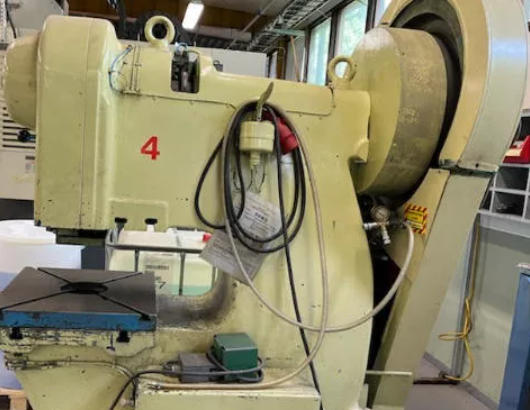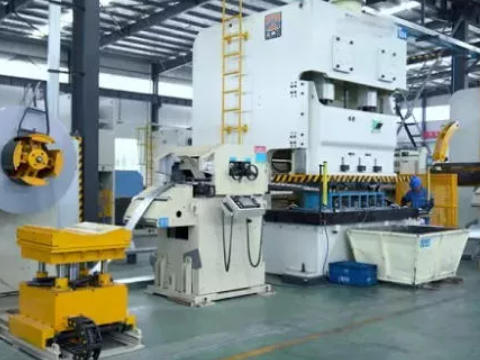Views: 222 Author: Rebecca Publish Time: 2025-11-19 Origin: Site









Content Menu
● Introduction to Cutlery Manufacturing and the Role of Punch Press Machines
● The Step-by-Step Journey of Cutlery Production with Punch Press Technology
>> 1. Raw Material Selection and Preparation
>> 2. Blanking Out Cutlery Shapes
>> 3. Rolling, Forming, and Trimming
>> 4. Piercing, Pattern Punching, and Embossing
>> 5. Forming, Bending, and Shaping
>> 6. Annealing and Heat Treatment
>> 7. Surface Grinding, Polishing, and Edge Finishing
>> 8. Cleaning and Ultrasonic Washing
>> 9. Inspection, Quality Control, and Packaging
● A Deeper Look at Punch Press Machine Technologies
>> Mechanical Vs. Hydraulic Punch Presses
>> Smart Manufacturing Integration
● The Environmental and Economic Impact of Modern Punch Presses
● Workforce Development and Operator Training
● Adapting Punch Press Technology for Custom and High-End Cutlery
● Safety, Maintenance, and Longevity
● Frequently Asked Questions (FAQ)
>> 1. What are the main steps in punch press-based cutlery production?
>> 2. How does a punch press enhance efficiency compared to traditional methods?
>> 3. Are punch press machines adaptable for custom or decorative cutlery?
>> 4. What maintenance practices are best for punch presses in the cutlery industry?
>> 5. How does automation in punch press processes benefit cutlery manufacturers?
Cutlery manufacturing, a sector that merges metallurgical mastery with aesthetic finesse, is heavily dependent on the advancements and adaptability of punch press machines. These dynamic workhorses form the backbone of stainless steel cutlery production, ensuring every knife, fork, and spoon is not just functional, but also precisely engineered for quality, durability, and visual appeal.

Modern cutlery manufacturing is far more than simply shaping metal into utensils. It is a sophisticated multi-step process involving material science, mechanical engineering, automation, and rigorous quality control. At the core of this intricate choreography stands the punch press machine—a tool essential for mass production that does not sacrifice precision or versatility.
Punch press machines function by using substantial force, applied through a die and punch system, to precisely cut, form, emboss, and pierce sheet metal. In the context of cutlery manufacturing, these operations lay the groundwork for transforming raw stainless steel into blanks, which are then skillfully formed, detailed, and finished into the utensils used every day in homes and restaurants worldwide.
The journey begins with the choice of raw material—most often, high-grade stainless steel such as 18/10, 304, or 420. These materials are chosen for their corrosion resistance, toughness, and ability to maintain a keen edge. Stainless steel coils or sheets are straightened, cleaned, and sometimes annealed to achieve the optimal characteristics for further processing.
Blanking is the primary operation where the punch press truly shines. Massive precision punching presses—sometimes up to 80 or even 300 tons—cut cleanly through the metal sheets, producing uniform cutlery blanks of various shapes and sizes for knives, forks, and spoons. The configuration of the die and the controlled force ensure minimal waste and repeatable accuracy.
Advanced punch presses integrate automatic feeding systems, able to straighten metal coils and sequence blanks at rapid speed, further reducing labor and material costs.
Directly following blanking, another series of forming operations takes place. Using cross-rolling machines, the heads of spoons or handles are flattened and widened. Specialized trimming presses remove excess material, ensuring every blank aligns perfectly with the desired contours of the finished piece.
This harmonized sequence—punching, rolling, and trimming—is repeated for each piece of cutlery, whether it's the rounded bowl of a spoon or the tapered profile of a knife.
With blanks secured, punch presses equipped with intricate dies are employed to punch holes, slots, or decorative indentations as dictated by the design. High-precision hydraulic presses are then used to emboss company logos, handle patterns, or signature surface textures.
Embossing is critical for branding and aesthetic differentiation. Whether for premium utensils with elaborate patterns or minimalist restaurant-grade flatware, the punch press ensures every detail is crisply rendered and permanently captured in the metal.
Forming presses and hydraulic presses step in to impart three-dimensional shape. Spoons receive their concave bowl, forks have tines bent and separated, and knife blades are shaped into ergonomic profiles. Bending is often achieved with specialized dies or servo-driven machines, offering perfect repeatability and customizability for different product lines.
Certain cutlery pieces require controlled annealing—a heat treatment process making the material more resistant to bending and improving durability. This is especially important for knife blades that must maintain a keen, long-lasting edge.
Once shaped, the utensils undergo a series of surface treatments. Edge grinding ensures there are no burrs or sharp imperfections. The surface is polished—by machine or by hand—using a series of abrasives and polishing wheels, ultimately leading to a mirror-like finish. Some finishes may be satin or matte, depending on design requirements.
Finishing machines can be semi-automatic or fully integrated into the punch press workflow, streamlining the process further.
At this stage, the cutlery is thoroughly cleaned. Automatic cleaning machines or ultrasonic baths remove surface residues, wax, and any metal particles left from grinding or polishing. This guarantees the utensils are both visually pristine and hygienic.
Sophisticated inspection systems—often using optical cameras or dimensional sensors—verify each piece meets stringent quality specifications. Any defective pieces are removed. Finished products are then packaged, sometimes after additional engraving or laser marking to add barcodes or serial numbers for tracking.

Mechanical punch presses are prized for high-speed, repetitive operations and excel in large-batch blanking and piercing. Hydraulic punch presses offer lower noise, smoother operation, and greater control over stroke and force, making them ideal for forming and embossing delicate or complex patterns.
Servo-driven presses, representing the newest wave of technology, unite the advantages of both, allowing variable stroke control and remarkable energy savings.
Computer Numerical Control (CNC) is increasingly integrated into punch press operations. CNC systems enable machines to switch between different die sets and adjust settings in real time, vastly improving flexibility and production speed. Factories can now produce a range of cutlery shapes and designs with minimal downtime.
Industry 4.0 advancements bring IoT sensors to monitor tool wear, force output, and production rates. This predictive maintenance ensures machines rarely run unscheduled downtime, streamlining production planning and minimizing costly disruptions.
With raw materials and energy costs perpetually increasing, punch press machines have been refined to maximize material utilization. Nesting software arranges cutlery blanks in optimal layouts, minimizing scrap. Servo-driven presses are significantly more energy efficient than their predecessors—sometimes using up to 40% less power.
Recycling programs for scrap metal ensure sustainable operations, and modern finishing systems reduce the need for hazardous chemicals in polishing and cleaning phases. These improvements not only lower costs but align cutlery manufacturers with global expectations for environmentally responsible production.
While automation reduces the need for heavy manual labor, skilled operators and engineers are still essential. Proper training in machine setup, die maintenance, safety procedures, and troubleshooting ensures smooth, efficient production and extends equipment lifespan.
Leading manufacturers invest in continuous education and cross-training, fostering an environment where lean manufacturing principles and safety best practices are part of the shop floor culture.
Not all cutlery production is mass market. Niche and luxury brands demand shorter runs, bespoke patterns, and non-standard alloys. Modern punch presses can quickly change dies and settings, accommodating these custom orders with the same precision and economy as large batches.
Laser-etching and micro-pattern embossing offer new ways to personalize cutlery, from family crests to professional branding, meeting the rising consumer demand for uniqueness and exclusivity.
Safety is paramount on the production floor. Modern punch presses are equipped with light curtains, emergency shutoff systems, and automated barriers. Regular preventive maintenance—checking lubrication, aligning dies, and monitoring critical wear points—ensures both continuous uptime and worker safety. Well-maintained machines can often provide decades of service with only periodic upgrades to their control systems.
Punch press machines, with their blend of brute force and meticulous precision, remain the foundation of modern cutlery manufacturing. From the first blank cut to the final polish, these machines empower manufacturers to produce vast quantities of forks, knives, and spoons—consistently meeting market demands for quality and innovation.
The evolution of punch press technology, especially the integration of automation, IoT, and sustainable systems, has ensured that today's factories are more efficient, adaptable, and environmentally conscious than ever before. As consumer preferences shift and the global tableware market expands, the role of advanced punch presses in crafting affordable, high-quality, and uniquely designed cutlery will continue to shape the industry's future.

The primary steps include material selection, blanking with a punch press, forming and trimming, piercing and pattern punching, forming and shaping, heat treatment, surface finishing and polishing, cleaning, and final inspection and packaging.
Punch press machines automate core operations, enable rapid production cycles, and vastly improve consistency and precision. The reduction in manual labor and defect rates leads to substantial savings and higher throughput.
Absolutely. Modern presses offer quick-change dies, CNC-controlled embossing, and advanced patterning capabilities that allow for short-run or custom-designed utensils alongside standard product lines.
Regular machinery lubrication, die alignment checks, periodic replacement of worn tools, and precise monitoring of force output and vibration are all key. Integrating IoT sensors allows for predictive maintenance and reduces downtime.
Automation brings improved speed, less operator fatigue, real-time process monitoring, and immediate adjustment for quality control. It also facilitates batch traceability and compliance with international manufacturing standards.
Why The Right Punch Press Machine Is Crucial for High-Quality Tableware Production?
Punch Press Machines: The Backbone of Efficient Cutlery Production
How To Choose Between Manual And Automatic Punch Press Machines?
Best Punch Press Machines for Small And Large-Scale Manufacturers
Top Manufacturers of Punch Press Machines for The Tableware Industry
What Are The Key Benefits of Investing in A Punch Press Machine for Your Factory?
How Punch Press Machines Are Revolutionizing The Cutlery Industry?
The Role of Punch Press Machines in Modern Kitchenware Production Lines
Punch Press Machine Vs. Turret Punch Press: What's The Difference?
